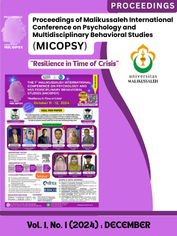A Survey of Student Bullying Bystander Behavior on Dayah (Islamic Boarding School in Aceh)
Keywords:
Bystander Behavior, Boarding School, Dayah, Bullying, Aceh, Bullying at schoo, Student Bystander Behavior ScaleAbstract
Bystander plays an important role in the occurrence of bullying. This study, aims to analyse students' bystander behaviour in bullying situations especially in dayah. 200 Dayah students in North Aceh Regency was being sample. The sampling technique used is purposive sampling. The bystander behavior scale was developed and modified by Thornberg & Jungert (2013) in the form of pro-bullying bystander, passive bystander, defender bystander. The scale has gone through the content validity stage with the Aiken's V with range of 0.825 - 0.930 The data indicates that, among 40 students at Dayah, some display pro-bullying behavior, 73 act as passive bystanders, and 87 take on the role of defenders in bullying situations. While most students are inclined to be defenders, a significant number also engage in passive bystander or pro-bullying behaviors. When broken down by gender, 13 male students exhibit pro-bullying behavior, 24 show passive behavior, and 24 take the role of defenders. For female students, 27 show pro-bullying tendencies, 49 act as passive bystanders, and 63 adopt the defender role. Overall, students are generally more likely to be defenders, though there is still a considerable presence of passive or pro-bullying behavior. Comparing males and females, males exhibit higher pro-bullying tendencies, while females are more likely to adopt passive bystander roles. Females are more likely to assume the defender role in bullying situations than males. Gender differences in how students respond to bullying, with males tending toward pro-bullying behaviors and females more often stepping in to defend others.





